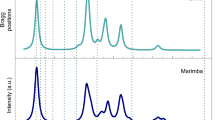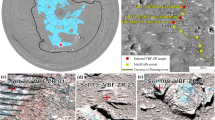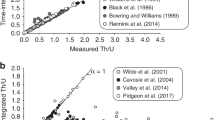Abstract
Precipitated minerals, including salts, are primary tracers of atmospheric conditions and water chemistry in lake basins. Ongoing in situ exploration by the Curiosity rover of Hesperian (around 3.3–3.7 Gyr old) sedimentary rocks within Gale crater on Mars has revealed clay-bearing fluvio-lacustrine deposits with sporadic occurrences of sulfate minerals, primarily as late-stage diagenetic veins and concretions. Here we report bulk enrichments, disseminated in the bedrock, of 30–50 wt% calcium sulfate intermittently over about 150 m of stratigraphy, and of 26–36 wt% hydrated magnesium sulfate within a thinner section of strata. We use geochemical analysis, primarily from the ChemCam laser-induced breakdown spectrometer, combined with results from other rover instruments, to characterize the enrichments and their lithology. The deposits are consistent with early diagenetic, pre-compaction salt precipitation from brines concentrated by evaporation, including magnesium sulfate-rich brines from extreme evaporative concentration. This saline interval represents a substantial hydrological perturbation of the lake basin, which may reflect variations in Mars’ obliquity and orbital parameters. Our findings support stepwise changes in Martian climate during the Hesperian, leading to more arid and sulfate-dominated environments as previously inferred from orbital observations.
This is a preview of subscription content, access via your institution
Access options
Access Nature and 54 other Nature Portfolio journals
Get Nature+, our best-value online-access subscription
$29.99 / 30 days
cancel any time
Subscribe to this journal
Receive 12 print issues and online access
$259.00 per year
only $21.58 per issue
Buy this article
- Purchase on Springer Link
- Instant access to full article PDF
Prices may be subject to local taxes which are calculated during checkout




Similar content being viewed by others
Data availability
All in situ and orbital data used in this study are available in the NASA Planetary Data System (https://pds-geosciences.wustl.edu). Other supplementary data that support the findings of this study are available from the corresponding author on reasonable request.
References
Tosca, N. J. & McLennan, S. M. Chemical divides and evaporite assemblages on Mars. Earth Planet. Sci. Lett. 241, 21–31 (2006).
Clark, B. C. et al. Chemistry and mineralogy of outcrops at Meridiani Planum. Earth Planet. Sci. Lett. 240, 73–94 (2005).
Tosca, N. J. et al. Geochemical modeling of evaporation processes on Mars: insight from the sedimentary record at Meridiani Planum. Earth Planet. Sci. Lett. 240, 122–148 (2005).
Ehlmann, B. L. & Edwards, C. S. Mineralogy of the Martian surface. Annu. Rev. Earth Planet. Sci. 42, 291–315 (2014).
Bibring, J.-P. et al. Global mineralogical and aqueous Mars history derived from OMEGA/Mars express data. Science 312, 400–404 (2006).
Le Deit, L. et al. Sequence of infilling events in Gale Crater, Mars: results from morphology, stratigraphy, and mineralogy. J. Geophys. Res. Planets 118, 2439–2473 (2013).
Fraeman, A. A. et al. The stratigraphy and evolution of lower Mount Sharp from spectral, morphological, and thermophysical orbital data sets. J. Geophys. Res. Planets 121, 1713–1736 (2016).
Milliken, R. E., Grotzinger, J. P. & Thomson, B. J. Paleoclimate of Mars as captured by the stratigraphic record in Gale Crater. Geophys. Res. Lett. 37, (2010).
Grotzinger, J. P. et al. Deposition, exhumation, and paleoclimate of an ancient lake deposit, Gale crater, Mars. Science 350, aac7575 (2015).
Hurowitz, J. A. et al. Redox stratification of an ancient lake in Gale crater, Mars. Science 356, eaah6849 (2017).
McLennan, S. M. et al. Elemental geochemistry of sedimentary rocks at Yellowknife Bay, Gale Crater, Mars. Science 343, 1244734 (2014).
Bristow, T. F. et al. Clay mineral diversity and abundance in sedimentary rocks of Gale crater, Mars. Sci. Adv. 4, eaar3330 (2018).
Nachon, M. et al. Calcium sulfate veins characterized by ChemCam/Curiosity at Gale crater, Mars. J. Geophys. Res. Planets 119, 2013JE004588 (2014).
Rapin, W. et al. Hydration state of calcium sulfates in Gale crater, Mars: identification of bassanite veins. Earth Planet. Sci. Lett. 452, 197–205 (2016).
Kah, L. C., Stack, K. M., Eigenbrode, J. L., Yingst, R. A. & Edgett, K. S. Syndepositional precipitation of calcium sulfate in Gale Crater, Mars. Terra Nova 30, 431–439 (2018).
Nachon, M. et al. Chemistry of diagenetic features analyzed by ChemCam at Pahrump Hills, Gale crater, Mars. Icarus 281, 121–136 (2017).
VanBommel, S. J. et al. Deconvolution of distinct lithology chemistry through oversampling with the Mars Science Laboratory Alpha Particle X-Ray Spectrometer. Xray Spectrom. 45, 155–161 (2016).
Mangold, N. et al. Chemical alteration of fine-grained sedimentary rocks at Gale crater. Icarus 321, 619–631 (2019).
Anderson, D. E. et al. Characterization of LIBS emission lines for the identification of chlorides, carbonates, and sulfates in salt/basalt mixtures for the application to MSL ChemCam data. J. Geophys. Res. Planets 122, 744–770 (2017).
Stack, K. M. et al. Evidence for plunging river plume deposits in the Pahrump Hills member of the Murray formation, Gale crater, Mars. Sedimentology 0, (2018).
Rapin, W. et al. Quantification of water content by laser induced breakdown spectroscopy on Mars. Spectrochim. Acta Part B At. Spectrosc. 130, 82–100 (2017).
Rivera-Hernández, F. et al. Using ChemCam LIBS data to constrain grain size in rocks on Mars: proof of concept and application to rocks at Yellowknife Bay and Pahrump Hills, Gale crater. Icarus 321, 82–98 (2019).
Warren, J. K. Evaporites: Sediments, Resources and Hydrocarbons (Springer Science & Business Media, 2006).
Handford, C. R. in Developments in Sedimentology, Vol. 50 (ed. Melvin, J. L.) 1–66 (Elsevier, 1991).
Giles, M. R. Diagenesis: A Quantitative Perspective: Implications for Basin Modelling and Rock Property Prediction (Kluwer Academic, 1997).
Chipera, S. J. & Vaniman, D. T. Experimental stability of magnesium sulfate hydrates that may be present on Mars. Geochim. Cosmochim. Acta 71, 241–250 (2007).
Holliday, D. W. The petrology of secondary gypsum rocks: a review. J. Sediment. Res. 40, 734–744 (1970).
Vaniman, D. T. et al. Gypsum, bassanite, and anhydrite at Gale crater, Mars. Am. Mineral. 103, 1011–1020 (2018).
Schieber, J. et al. Encounters with an unearthly mudstone: understanding the first mudstone found on Mars. Sedimentology 64, 311–358 (2017).
Gustavson, T. C., Hovorka, S. D. & Dutton, A. R. Origin of satin spar veins in evaporite basins. J. Sediment. Res. 64, 88–94 (1994).
Thomas, N. H. et al. Mars Science Laboratory Observations of Chloride Salts in Gale Crater, Mars. Geographic. Res. Lett. https://doi.org/10.1029/2019GL082764 (2019).
Wang, A., Freeman, J. J. & Jolliff, B. L. Phase transition pathways of the hydrates of magnesium sulfate in the temperature range 50°C to 5°C: implication for sulfates on Mars. J. Geophys. Res. Planets 114, E04010 (2009).
Vaniman, D. T. & Chipera, S. J. Transformations of Mg- and Ca-sulfate hydrates in Mars regolith. Am. Mineral. 91, 1628–1642 (2006).
Stein, N. et al. Desiccation cracks provide evidence of lake drying on Mars, Sutton Island member, Murray formation, Gale Crater. Geology 46, 515–518 (2018).
Chemcam passive reflectance spectroscopy of recent drill tailings, hematite-bearing rocks, and dune sands. in 47, 1155 (2016).
Tosca, N. J., Ahmed, I. A. M., Tutolo, B. M., Ashpitel, A. & Hurowitz, J. A. Magnetite authigenesis and the warming of early Mars. Nat. Geosci. 11, 635 (2018).
Cabestrero, Ó., del Buey, P. & Sanz-Montero, M. E. Biosedimentary and geochemical constraints on the precipitation of mineral crusts in shallow sulphate lakes. Sediment. Geol. 366, 32–46 (2018).
Kilmer, B. R. et al. Molecular and phenetic characterization of the bacterial assemblage of Hot Lake, WA, an environment with high concentrations of magnesium sulfate, and its relevance to Mars. Int. J. Astrobiol. 13, 69–80 (2014).
Pontefract, A. et al. Microbial diversity in a hypersaline sulfate lake: a terrestrial analog of ancient Mars. Front. Microbiol. 8, 1819 (2017).
Aubrey, A. et al. Sulfate minerals and organic compounds on Mars. Geology 34, 357–360 (2006).
Fedo, C. et al. Sedimentology and stratigraphy of the Murray formation, Gale crater, Mars. In 49th Lunar and Planetary Science Conference 2018, 2078 (Lunar Planetary Institute, 2018).
Schieber, J. et al. A sand-lens in the upper Murray formation at Gale crater, Mars: a likely lowstand deposit of a dynamic ancient lake. in 48, 2311 (2017).
Laskar, J. et al. Long term evolution and chaotic diffusion of the insolation quantities of Mars. Icarus 170, 343–364 (2004).
Grotzinger, J. P. et al. Mars Science Laboratory mission and science investigation. Space Sci. Rev. 170, 5–56 (2012).
Mitrofanov, I. et al. Studying of water consent in Mars’ gale crater: the first results of the DAN experiment on the NASA curiosity rover. Dokl. Phys. 59, 126–128 (2014).
Maurice, S. et al. The ChemCam instrument suite on the Mars Science Laboratory (MSL) rover: science objectives and mast unit description. Space Sci. Rev. 170, 95–166 (2012).
Wiens, R. C. et al. The ChemCam instrument suite on the Mars Science Laboratory (MSL) rover: body unit and combined system tests. Space Sci. Rev. 170, 167–227 (2012).
Clegg, S. M. et al. Recalibration of the Mars Science Laboratory ChemCam instrument with an expanded geochemical database. Spectrochim. Acta Part B 129, 64–85 (2017).
Dyar, M. D. et al. Strategies for Mars remote laser-induced breakdown spectroscopy analysis of sulfur in geological samples. Spectrochim. Acta Part B 66, 39–56 (2011).
Schröder, S., Pavlov, S. G., Rauschenbach, I., Jessberger, E. K. & Hübers, H.-W. Detection and identification of salts and frozen salt solutions combining laser-induced breakdown spectroscopy and multivariate analysis methods: a study for future Martian exploration. Icarus 223, 61–73 (2013).
Sobron, P., Wang, A. & Sobron, F. Extraction of compositional and hydration information of sulfates from laser-induced plasma spectra recorded under Mars atmospheric conditions—implications for ChemCam investigations on Curiosity rover. Spectrochim. Acta Part B 68, 1–16 (2012).
McGuire, P. C. et al. An improvement to the volcano-scan algorithm for atmospheric correction of CRISM and OMEGA spectral data. Planet. Space Sci. 57, 809–815 (2009).
Stamnes, K., Tsay, S., Wiscombe, W. & Jayaweera, K. Numerically stable algorithm for discrete-ordinate-method radiative transfer in multiple scattering and emitting layered media. Appl. Opt. 27, 2502–2509 (1988).
He, L., O’Sullivan, J. A., Politte, D. V., Powell, K. E. & Arvidson, R. E. Quantitative reconstruction and denoising method HyBER for hyperspectral image data and its application to CRISM. IEEE J. STARS 12, 1219–1230 (2019).
Cloutis, E. A. et al. Detection and discrimination of sulfate minerals using reflectance spectroscopy. Icarus 184, 121–157 (2006).
Acknowledgements
Thanks to the MSL operations team for their dedication in generating this dataset, and to the LANL team for collection of data to support sulfur calibration. Thanks to J. Grotzinger, C. Fedo, K. Siebach, L. Edgar and other members of the informal MSL Sed-Strat group for discussions that helped improve this work. The authors also thank S. Clegg and other members of the ChemCam team for discussions on sulfur signal calibration. W.R. and B.L.E. were funded by a MSL Participating Scientist grant NNN12AA01C. The work of G.D. was supported by the CNES through the ChemCam Program. This work and the MSL project are supported by the NASA Mars Exploration Program.
Author information
Authors and Affiliations
Contributions
W.R. analysed the LIBS and image data and conceived and wrote the manuscript. W.R., B.L.E. and G.D. conceived and revised the manuscript. J.S., W.W.F., B.C.C., L.C.K., N.M., R.C.W. and A.R.V., contributed to the interpretation of the data and revisions of the manuscript. N.H.T. provided LIBS chloride peak analyses. V.K.F. analysed CRISM signatures of hydrated sulfates. N.T.S. and F.R.H. provided grain size estimates from Mars Hand Lens Imager (MAHLI) images of Murray bedrock. M.N. and H.A.M. identified and mapped sulfate vein occurrences. L.T. analysed APXS data of Murray bedrock. T.S.J.G. and C.H. provided DAN data analysis.
Corresponding author
Ethics declarations
Competing interests
The authors declare no competing interests.
Additional information
Peer review information Primary handling editor(s): Stefan Lachowycz.
Publisher’s note Springer Nature remains neutral with regard to jurisdictional claims in published maps and institutional affiliations.
Supplementary information
Supplementary Information
Supplementary Figs. 1–15 and Supplementary Tables 1–3.
Rights and permissions
About this article
Cite this article
Rapin, W., Ehlmann, B.L., Dromart, G. et al. An interval of high salinity in ancient Gale crater lake on Mars. Nat. Geosci. 12, 889–895 (2019). https://doi.org/10.1038/s41561-019-0458-8
Received:
Accepted:
Published:
Issue Date:
DOI: https://doi.org/10.1038/s41561-019-0458-8
This article is cited by
-
Sulfur-cycling chemolithoautotrophic microbial community dominates a cold, anoxic, hypersaline Arctic spring
Microbiome (2023)
-
Ecological successions throughout the desiccation of Tirez lagoon (Spain) as an astrobiological time-analog for wet-to-dry transitions on Mars
Scientific Reports (2023)
-
Sustained wet–dry cycling on early Mars
Nature (2023)
-
Exploring the evidence of Middle Amazonian aquifer sedimentary outburst residues in a Martian chaotic terrain
Scientific Reports (2023)
-
Raman spectroscopic peculiarities of Icelandic poorly crystalline minerals and their implications for Mars exploration
Scientific Reports (2022)



